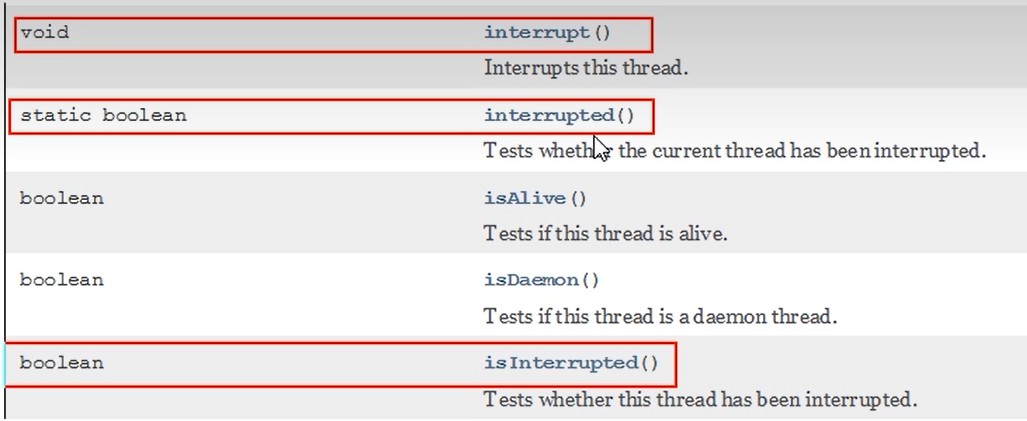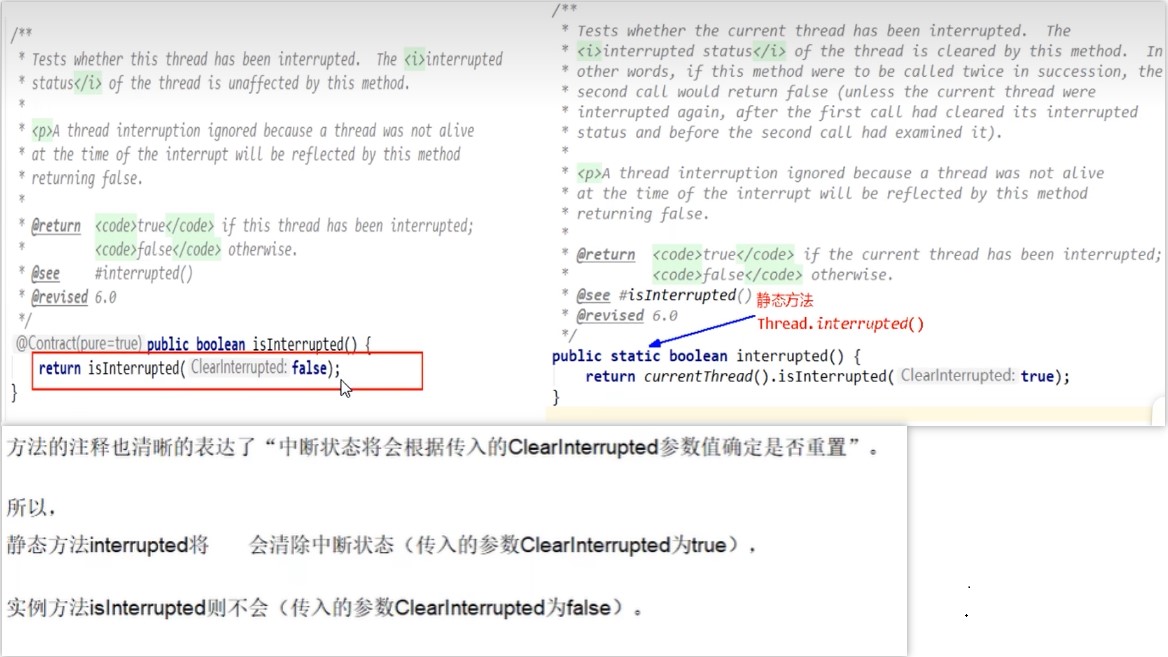线程中断机制
中断机制
一个线程不应由其他线程来强制中断或停止,而应该由线程自己自行停止,因此Thread.stop/suspend/resume被废弃。Java提供了一种用于停止线程的协商机制—中断,它只是一种协作协商机制,Java没有给中断增加任何语法。
若要中断一个线程,你需要手动调用该线程的interrupt方法,该方法也仅仅是将线程对象的中断标识设成true;接着需要自己写代码检测当前线程的标识位,如果为true,表示别的线程请求这条线程中断。
每个线程对象中都有一个中断标识位,用于表示线程是否被中断,该标识位为true表示中断,为false表示未中断。该方法可以在别的线程中调用,也可以在自己的线程中调用。

中断API
| 方法 |
说明 |
public void interrupt() |
实例方法,仅仅设置线程的中断状态为true,发起一个协商而不会立即停止一个线程 |
public static boolean interrupted() |
静态方法,判断线程是否被中断并清除当前中断状态;1. 返回当前线程的中断状态,测试当前线程是否已被中断;2. 将当前线程的状态状态清零,并重新设为flase,清除线程的中断状态。如果连续两次调用此方法,则第二次调用将返回false,因为连续调用两次的结果可能不一样 |
public boolean isInterrupted() |
实例方法,判断当前线程是否被中断(检查中断标志位) |
public static boolean interrupted()

疑难解答
如何停止中断运行中的线程?
使用volatile变量实现
1
2
3
4
5
6
7
8
9
10
11
12
13
14
15
16
17
18
19
20
21
22
23
24
25
26
27
28
29
30
31
32
33
34
35
36
37
38
39
40
41
| public class VolatileDemo {
private static volatile boolean isStop = false;
public static void main(String[] args) {
new Thread(() -> {
while (true) {
if (isStop) {
System.out.println(Thread.currentThread().getName() + "\t isStop 改为true, 程序停止");
break;
}
System.out.println("t1************** hello volatile");
}
}, "t1").start();
try {
TimeUnit.MILLISECONDS.sleep(20);
} catch (InterruptedException e) {
e.printStackTrace();
}
new Thread(() -> {
isStop = true;
}, "t2").start();
}
}
t1************** hello volatile
t1************** hello volatile
t1************** hello volatile
t1************** hello volatile
t1************** hello volatile
t1************** hello volatile
t1************** hello volatile
t1************** hello volatile
t1************** hello volatile
t1************** hello volatile
t1************** hello volatile
t1************** hello volatile
t1 isStop 改为true, 程序停止
|
使用AtomicBoolean
1
2
3
4
5
6
7
8
9
10
11
12
13
14
15
16
17
18
19
20
21
22
23
24
25
26
27
| public class AtomicBooleanDemo {
private static AtomicBoolean atomicBoolean = new AtomicBoolean(false);
public static void main(String[] args) {
new Thread(() -> {
while (true) {
if (atomicBoolean.get()) {
System.out.println(Thread.currentThread().getName() + "\t atomicBoolean 改为true, 程序停止");
break;
}
System.out.println("t1************** hello atomicBoolean");
}
}, "t1").start();
try {
TimeUnit.MILLISECONDS.sleep(20);
} catch (InterruptedException e) {
e.printStackTrace();
}
new Thread(() -> {
atomicBoolean.set(true);
}, "t2").start();
}
}
|
使用Thread类自带的中断api实例方法实现
1
2
3
4
5
6
7
8
9
10
11
12
13
14
15
16
17
18
19
20
21
22
23
24
| public class InterruptDemo {
public static void main(String[] args) {
Thread t1 = new Thread(() -> {
while (true) {
if (Thread.currentThread().isInterrupted()) {
System.out.println(Thread.currentThread().getName() + "\t isInterrupted 改为true, 程序停止");
break;
}
System.out.println("t1************** hello interrupt api");
}
}, "t1");
t1.start();
try {
TimeUnit.MILLISECONDS.sleep(20);
} catch (InterruptedException e) {
e.printStackTrace();
}
new Thread(t1::interrupt, "t2").start();
}
}
|
在需要中断的线程中不断监听中断状态,一旦发生中断,就执行相应的中断处理业务逻辑stop线程
当对一个线程调用interrupt()时
- 如果线程处于正常活动状态,那么会将该线程的中断标志设置为true,仅此而已。被设置中断标志的线程将继续正常运行,不受影响。所以,interrupt()并不能真正的中断线程,需要被调用的线程自己进行配合才行。
- 如果线程处于被阻塞状态(例如处于sleep, wait, join等状态),在别的线程中调用当前线程对象的interrupt方法,那么线程将立即退出被阻塞状态,并抛出一个InterruptedException异常。

当前线程的中断标识为true,是不是线程就立刻停止?
中断只是一种协商机制,修改中断标识位仅此而已,不是立刻stop打断
谈谈你对静态方法Thread.interrupted的理解?

总结

LockSupport
LockSupport用于创建锁和其他同步类的基本线程阻塞原语,其方法park()是阻塞线程和unpark()是解除阻塞线程

- LockSupport是用来创建锁和其他同步类的基本线程阻塞原语。
- LockSupport类使用了一种名为Permit(许可)的概念来做到阻塞和唤醒线程的功能,每个线程都有一个许可(permit)
- 但与 Semaphore不同的是,许可的累加上限是
1

permit许可证默认没有不能放行,所以一开始调pak()方法当前线程就会阻塞,直到别的线程给当前线程的发放permit,park方法才会被咳醒。

调用unpark(thread)方法后,就会将thread线程的许可证permit发放,会自动唤醒park线程,即之前阻塞中的LockSupport.park()方法会立即返回。
线程等待唤醒机制
线程等待唤醒方法
使用Object中的wait()方法使线程等待,使用Object中的notify()方法唤醒线程
正常情况
1
2
3
4
5
6
7
8
9
10
11
12
13
14
15
16
17
18
19
20
21
22
23
24
25
26
27
28
29
30
31
32
| public static void main(String[] args) {
Object objectLock = new Object();
new Thread(()->{
synchronized (objectLock) {
System.out.println(Thread.currentThread().getName() + "\t ********* 进来了");
try {
objectLock.wait();
} catch (InterruptedException e) {
e.printStackTrace();
}
System.out.println(Thread.currentThread().getName() + "\t ****** 被唤醒");
}
}, "t1").start();
try {
TimeUnit.SECONDS.sleep(1);
} catch (InterruptedException e) {
e.printStackTrace();
}
new Thread(()->{
synchronized (objectLock) {
objectLock.notify();
System.out.println(Thread.currentThread().getName() + "\t ********* 发出通知");
}
}, "t2").start();
}
t1 ********* 进来了
t2 ********* 发出通知
t1 ****** 被唤醒
|
异常情况1:wait()和notify()两个都去掉同步代码块
1
2
3
4
5
6
7
8
9
10
11
12
13
14
15
16
17
18
19
20
21
22
23
24
25
26
27
28
| public static void main(String[] args) {
Object objectLock = new Object();
new Thread(()->{
System.out.println(Thread.currentThread().getName() + "\t ********* 进来了");
try {
objectLock.wait();
} catch (InterruptedException e) {
e.printStackTrace();
}
System.out.println(Thread.currentThread().getName() + "\t ****** 被唤醒");
}, "t1").start();
try {
TimeUnit.SECONDS.sleep(1);
} catch (InterruptedException e) {
e.printStackTrace();
}
new Thread(()->{
objectLock.notify();
System.out.println(Thread.currentThread().getName() + "\t ********* 发出通知");
}, "t2").start();
}
|
程序异常

异常情况2:将notify()放在wait()方法前
程序无法执行,无法唤醒

总结
wait()和notify()必须在同步方法块或方法里面并且成对出现使用- 使用顺序:先
wait()然后notify()
使用JUC中Condition的await()方法使线程等待,使用signal()方法唤醒线程
正常情况
1
2
3
4
5
6
7
8
9
10
11
12
13
14
15
16
17
18
19
20
21
22
23
24
25
26
27
28
29
30
31
32
33
34
35
36
37
38
| public static void main(String[] args) {
Lock lock = new ReentrantLock();
Condition condition = lock.newCondition();
new Thread(()-> {
lock.lock();
try {
System.out.println(Thread.currentThread().getName() + "\t ********* 进来了");
condition.await();
System.out.println(Thread.currentThread().getName() + "\t ****** 被唤醒");
} catch (InterruptedException e) {
e.printStackTrace();
} finally {
lock.unlock();
}
}, "t1").start();
try {
TimeUnit.SECONDS.sleep(1);
} catch (InterruptedException e) {
e.printStackTrace();
}
new Thread(()->{
try {
lock.lock();
condition.signal();
System.out.println(Thread.currentThread().getName() + "\t ********* 发出通知");
} finally {
lock.unlock();
}
}, "t2").start();
}
t1 ********* 进来了
t2 ********* 发出通知
t1 ****** 被唤醒
|
异常情况1:去掉lock/unlock
出现异常

异常情况2:将signal()放在await()方法前
程序无法运行

结论
上述两个对象Object和Condition使用的限制
- 线程先要获得并持有锁,必须在锁块(synchronized或lock)中
- 必须要先等待后唤醒,线程才能够被唤醒
心
使用LockSupport类可以阻塞当前线程以及唤醒指定被阻塞的线程
1
2
3
4
5
6
7
8
9
10
11
12
13
14
15
16
17
18
19
20
21
| public static void main(String[] args) {
Thread t1 = new Thread(() -> {
System.out.println(Thread.currentThread().getName() + "\t ********* 进来了");
LockSupport.park();
System.out.println(Thread.currentThread().getName() + "\t ****** 被唤醒");
}, "t1");
t1.start();
try {
TimeUnit.SECONDS.sleep(1);
} catch (InterruptedException e) {
e.printStackTrace();
}
new Thread(() -> {
LockSupport.unpark(t1);
System.out.println(Thread.currentThread().getName() + "\t ********* 发出通知");
}, "t2").start();
}
|
如果与上述一样先唤醒后等待(异常情况),LockSupport照样支持,但要牢记成双成对

总结
为什么LockSupport可以突破wait/notify的原有调用顺序
因为unpark获得了一个凭证,之后再调用park方法,就可以名正言顺的凭证消费,故不会阻塞。先发放了凭证后续可以畅通无阻、
为什么唤醒两次后阻塞两次,但最终结果还会阻塞线程?
因为凭证的数量最多为1,连续调用两次unpark和调用一次unpark效果一样,只会增加一个凭证;而调用两次park却需要消费两个凭证,证不够,不能放行。























